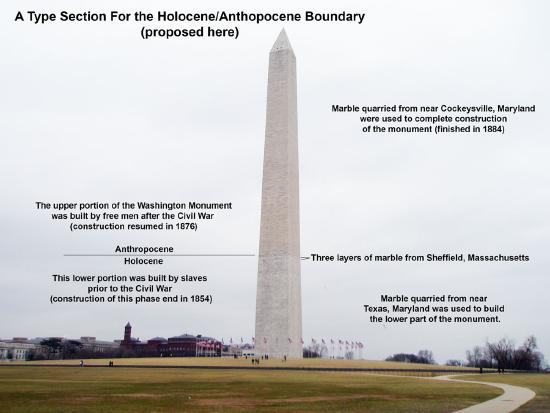2.30: The Anthropocene Epoch (1865 AD to present)?
- Page ID
- 9799
\( \newcommand{\vecs}[1]{\overset { \scriptstyle \rightharpoonup} {\mathbf{#1}} } \)
\( \newcommand{\vecd}[1]{\overset{-\!-\!\rightharpoonup}{\vphantom{a}\smash {#1}}} \)
\( \newcommand{\id}{\mathrm{id}}\) \( \newcommand{\Span}{\mathrm{span}}\)
( \newcommand{\kernel}{\mathrm{null}\,}\) \( \newcommand{\range}{\mathrm{range}\,}\)
\( \newcommand{\RealPart}{\mathrm{Re}}\) \( \newcommand{\ImaginaryPart}{\mathrm{Im}}\)
\( \newcommand{\Argument}{\mathrm{Arg}}\) \( \newcommand{\norm}[1]{\| #1 \|}\)
\( \newcommand{\inner}[2]{\langle #1, #2 \rangle}\)
\( \newcommand{\Span}{\mathrm{span}}\)
\( \newcommand{\id}{\mathrm{id}}\)
\( \newcommand{\Span}{\mathrm{span}}\)
\( \newcommand{\kernel}{\mathrm{null}\,}\)
\( \newcommand{\range}{\mathrm{range}\,}\)
\( \newcommand{\RealPart}{\mathrm{Re}}\)
\( \newcommand{\ImaginaryPart}{\mathrm{Im}}\)
\( \newcommand{\Argument}{\mathrm{Arg}}\)
\( \newcommand{\norm}[1]{\| #1 \|}\)
\( \newcommand{\inner}[2]{\langle #1, #2 \rangle}\)
\( \newcommand{\Span}{\mathrm{span}}\) \( \newcommand{\AA}{\unicode[.8,0]{x212B}}\)
\( \newcommand{\vectorA}[1]{\vec{#1}} % arrow\)
\( \newcommand{\vectorAt}[1]{\vec{\text{#1}}} % arrow\)
\( \newcommand{\vectorB}[1]{\overset { \scriptstyle \rightharpoonup} {\mathbf{#1}} } \)
\( \newcommand{\vectorC}[1]{\textbf{#1}} \)
\( \newcommand{\vectorD}[1]{\overrightarrow{#1}} \)
\( \newcommand{\vectorDt}[1]{\overrightarrow{\text{#1}}} \)
\( \newcommand{\vectE}[1]{\overset{-\!-\!\rightharpoonup}{\vphantom{a}\smash{\mathbf {#1}}}} \)
\( \newcommand{\vecs}[1]{\overset { \scriptstyle \rightharpoonup} {\mathbf{#1}} } \)
\( \newcommand{\vecd}[1]{\overset{-\!-\!\rightharpoonup}{\vphantom{a}\smash {#1}}} \)
\(\newcommand{\avec}{\mathbf a}\) \(\newcommand{\bvec}{\mathbf b}\) \(\newcommand{\cvec}{\mathbf c}\) \(\newcommand{\dvec}{\mathbf d}\) \(\newcommand{\dtil}{\widetilde{\mathbf d}}\) \(\newcommand{\evec}{\mathbf e}\) \(\newcommand{\fvec}{\mathbf f}\) \(\newcommand{\nvec}{\mathbf n}\) \(\newcommand{\pvec}{\mathbf p}\) \(\newcommand{\qvec}{\mathbf q}\) \(\newcommand{\svec}{\mathbf s}\) \(\newcommand{\tvec}{\mathbf t}\) \(\newcommand{\uvec}{\mathbf u}\) \(\newcommand{\vvec}{\mathbf v}\) \(\newcommand{\wvec}{\mathbf w}\) \(\newcommand{\xvec}{\mathbf x}\) \(\newcommand{\yvec}{\mathbf y}\) \(\newcommand{\zvec}{\mathbf z}\) \(\newcommand{\rvec}{\mathbf r}\) \(\newcommand{\mvec}{\mathbf m}\) \(\newcommand{\zerovec}{\mathbf 0}\) \(\newcommand{\onevec}{\mathbf 1}\) \(\newcommand{\real}{\mathbb R}\) \(\newcommand{\twovec}[2]{\left[\begin{array}{r}#1 \\ #2 \end{array}\right]}\) \(\newcommand{\ctwovec}[2]{\left[\begin{array}{c}#1 \\ #2 \end{array}\right]}\) \(\newcommand{\threevec}[3]{\left[\begin{array}{r}#1 \\ #2 \\ #3 \end{array}\right]}\) \(\newcommand{\cthreevec}[3]{\left[\begin{array}{c}#1 \\ #2 \\ #3 \end{array}\right]}\) \(\newcommand{\fourvec}[4]{\left[\begin{array}{r}#1 \\ #2 \\ #3 \\ #4 \end{array}\right]}\) \(\newcommand{\cfourvec}[4]{\left[\begin{array}{c}#1 \\ #2 \\ #3 \\ #4 \end{array}\right]}\) \(\newcommand{\fivevec}[5]{\left[\begin{array}{r}#1 \\ #2 \\ #3 \\ #4 \\ #5 \\ \end{array}\right]}\) \(\newcommand{\cfivevec}[5]{\left[\begin{array}{c}#1 \\ #2 \\ #3 \\ #4 \\ #5 \\ \end{array}\right]}\) \(\newcommand{\mattwo}[4]{\left[\begin{array}{rr}#1 \amp #2 \\ #3 \amp #4 \\ \end{array}\right]}\) \(\newcommand{\laspan}[1]{\text{Span}\{#1\}}\) \(\newcommand{\bcal}{\cal B}\) \(\newcommand{\ccal}{\cal C}\) \(\newcommand{\scal}{\cal S}\) \(\newcommand{\wcal}{\cal W}\) \(\newcommand{\ecal}{\cal E}\) \(\newcommand{\coords}[2]{\left\{#1\right\}_{#2}}\) \(\newcommand{\gray}[1]{\color{gray}{#1}}\) \(\newcommand{\lgray}[1]{\color{lightgray}{#1}}\) \(\newcommand{\rank}{\operatorname{rank}}\) \(\newcommand{\row}{\text{Row}}\) \(\newcommand{\col}{\text{Col}}\) \(\renewcommand{\row}{\text{Row}}\) \(\newcommand{\nul}{\text{Nul}}\) \(\newcommand{\var}{\text{Var}}\) \(\newcommand{\corr}{\text{corr}}\) \(\newcommand{\len}[1]{\left|#1\right|}\) \(\newcommand{\bbar}{\overline{\bvec}}\) \(\newcommand{\bhat}{\widehat{\bvec}}\) \(\newcommand{\bperp}{\bvec^\perp}\) \(\newcommand{\xhat}{\widehat{\xvec}}\) \(\newcommand{\vhat}{\widehat{\vvec}}\) \(\newcommand{\uhat}{\widehat{\uvec}}\) \(\newcommand{\what}{\widehat{\wvec}}\) \(\newcommand{\Sighat}{\widehat{\Sigma}}\) \(\newcommand{\lt}{<}\) \(\newcommand{\gt}{>}\) \(\newcommand{\amp}{&}\) \(\definecolor{fillinmathshade}{gray}{0.9}\)The Anthropocene Epoch (1865 AD to present)?
The name Holocene Epoch has been applied to the time period extending from the end of the last ice age, encompassing the rise of human civilizations up to the present time. However, the name Anthropocene has been suggested to designate the current geological age, viewed as the period during which human activity has become the dominant influence on climate and the physical environment. Some question are: When did this happen? And, how will generations of consciously aware descendants of our times (human and otherwise) be able to recognize it from landforms and layers with sedimentary deposits? Many suggestions have been made, and deposits in one region may not completely match characteristics in another region. (This is an excellent discussion topic for examining other extinction boundaries in the geologic past!) Here are points to consider: when did the Anthropocene begin?
• Many scientists think the beginning of the Anthropocene began with the Industrial Revolution in the 1850s; the logical start starting point to the modern era. The start of the Industrial Revolution marks when major extraction of mineral resources began (coal, iron, and other metals), the spread transportation networks, the growth and expansion urban development.
• Durable pollen from eucalyptus trees imported from Australia and New Zealand to support expansion or the railroads start to appear in sediments throughout California sedimentary basin deposits starting in the 1850s.
• Mass production and distribution of durable glass, porcelain products, and lead bullets started in the 1850s, beginning the contribution to throw-away society materials that can be found in abundance wherever humans went. Durable man-made products began to accumulate as trash in the environment.
 Figure 2.81. The Washington Monument is a possibly a good choice for a type section for the Holocene/Anthropocene Boundary. The lower part of the monument was built (by slaves) before the Industrial Revolution began. The upper part of monument was completed in a second construction phase after the Civil War (by free men) after the Industrial Revolution was well in progress.
Figure 2.81. The Washington Monument is a possibly a good choice for a type section for the Holocene/Anthropocene Boundary. The lower part of the monument was built (by slaves) before the Industrial Revolution began. The upper part of monument was completed in a second construction phase after the Civil War (by free men) after the Industrial Revolution was well in progress.
Interestingly, the H/A Boundary level depicted on the Washington Monument approximately marks the level that sea level will rise to if most of the ice on Greenland and Antarctica were to melt due to global warming (as has already occurred in the geologic past).
A later start to the Anthropocene Epoch is suggested for post World War II. Sediments from this period include:
• A universal boundary world-wide where radioactive isotopes and byproducts of the surface testing of nuclear weapons can now be identified as a boundary in sedimentary deposit around the world.
• Durable plastics, construction materials, porcelain tiles, composite materials, and other durable trash of the modern era released intentionally or accidentally (such as damaging effect caused by superstorm damage, tsunamis, floods, or other disasters) are now distributed throughout the environment.
• Construction of sprawling urban area, mining regions, transportation routes (such as interstate highways) , and agricultural activities have significantly modified the landscape in many regions that will have lasting effect on the landscape for many millennium into the future. Some estimates suggest that human activities are moving more materials than all the rivers, wind, ocean currents, and other natural geologic processes combined.
• Landfills will be a long-lasting time stamp on the landscape worldwide.
• Introduction of exotic species have completely changed the environment in many regions.
This discussion has many intriguing manifestations. Can humans organize and adjust to what might be considered sustainability? Or, perhaps without hope, are we destined to an apocalyptic fate as describe by Thomas Malthus (1766-1834), an English economist and demographer who proposed a theory that human population growth will always tend to outrun the food supply. Malthus suggested that the betterment of humankind is impossible without strict enforcement of limits on reproduction. So far in our modern era, it seems that some of the limitations on what might be considered sustainable have been addressed by advancing technology and changing social norms (globally). The question is, can we collectively achieve sustainability without enduring war, disease, and famine?



